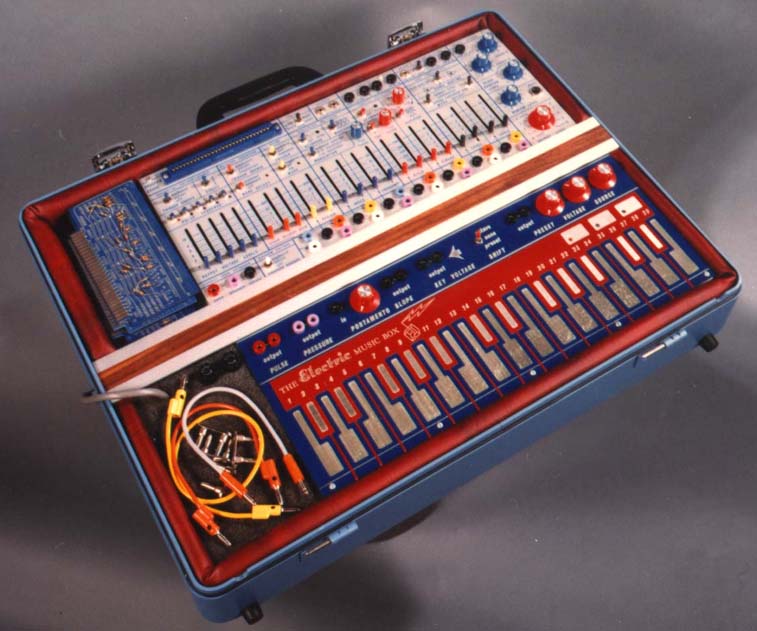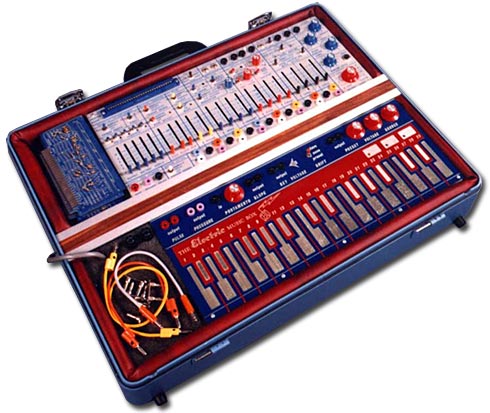Description | The Music Easel, released in 1972/73, is a very rare compact Buchla synth that had the Model 208 Stored Program Sound Source module inside of a Model 203-8 briefcase-style metal case. It also used the Model 218 pressure-sensitive touch-plate keyboard (with 32 keys). As small as it was it managed to include a 5-stage sequencer, 22 sliders, and over 25 color-coded patch-points. The Music Easel was housed in an aluminum case that closed up like a brief-case for travel purposes with room for its patch cords and memory cards. It is quite similar to the EMS Synthi AKS, but likely more flexible, programmable and even more rare.
The Music Easel also featured a relative breakthrough for its time: Patch storage! But it was rudimentary storage - resistors installed to "program" cards were used. You needed one card full of resistors for each patch and they had to be manually plugged in to be used. They stored slider, switch and knob positions as well as patch-point connections. To be used they had to be inserted into a slot, one at a time, on the upper left side of the synth. They can also be seen in the picture above in their own storage compartment directly above the patch cord storage compartment. The Music Easel originally sold with six blank cards and some resistors and instructions. There was even a re-chargeable battery pack for added portability (up to 3 hours).
The Music Easel is a highly evolved electronic musical instrument. It maintains many of the design philosophies and functional characteristics of its predecessors, the 100 series Modular Electronic Music System and the 200 series Electric Music Box. The Music Easel introduces some substantial innovations in electronic instrument design - innovations that make it a truly expressive real-time instrument for composition and performance.
The Music Easel contains many of the elements commonly used to generate and process sound: a keyboard, sequencer, pulser, preamplifier, envelope detector and balanced modulator; oscillators, gates, envelope generators and filters; facilities for mixing, monitoring and reverberating. Many of these elements possess an unusual degree of sophistication. The keyboard is solid state, with touch sensitive, chromatically organized keys, accurate and reproducible pressure output, tactile feedback, octave shifting, and voltage controlled portamento. A complex oscillator, developed through computer aided simulation studies, is a rich source of complex audio spectra. featuring voltage control of pitch, timbre and waveform, this oscillator provides the Music Easel with a timbral range unapproached by other musical instruments.
The connectives are as important as the elements to be connected. Interconnection within the Music Easel is accomplished with a combination of switching and patching, a system which is flexible, expedient, and open ended. Logical, compact organization and color coded graphic feedback facilitate rapid and effective interaction. Multiple correlations between a performer's actions and the Music Easel's responses are readily implemented, enabling a degree of expressive articulation heretofore impossible with electronic instrumentation.
Further augmenting the Music Easel's real time performability is the capability of permanently storing and immediately retrieving complete instrument definitions (patches) or portions thereof. (An "instrument definition" includes settings of parameters, degrees of articulation, switch positions and interconnections.) Storage entails the installment of resistors on program cards; retrieval is accomplished by plugging in a desired program card and activating a switch.
With its extended timbral resources, unusual expressive capability, and its facility for storage and recall of instrument definitions, the Music Easel opens new horizons to the composer and performer. To appreciate its potential as a new musical instrument the Music Easel must be seen, heard and played.
Music Easels are provided with six blank program cards, an assortment of programming resistors, and a comprehensive instruction manual. Available accessories include additional program cards and resistors and a 12 volt battery pack. Complete with case and charger, this battery pack will power a Music Easel for approximately three hours per charge. Electrical requirements are 30 watts at 110 volts A.C. or 2 amperes at 12 volts D.C. Preamp input impedance is 1 megaohm; gain is 30 dB. Nominal program output level is 1 volt R.M.S., sufficient to drive tape recorders or power amplifiers. A separate 2 watt monitor output will drive headsets or low level speakers.
Housed in a rugged aluminum case, the Music Easel is built to travel. Weight is 30 pounds; dimensions are 6" x 17" x 22" (carry on baggage for jetliners).
|




